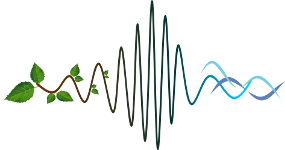Anthropogenic noise is a growing concern among stakeholders since it causes negative impacts on animal communication and their wellbeing. Particularly, mining activity produces high levels of noise through heavy machinery, busy roads, explosions and frequent sirens during the day and night. An important part of the Brazilian economy is based on mining, which is often conducted in habitats considered biodiversity hotspots with many threatened and endemic species. The Atlantic forest biome is one of the habitats that is commonly affected by the mining noise. Were characterized and compared the soundscapes of two different areas in the same Atlantic forest fragment in Southeast of Brazil: 1) noise-polluted environment – at a distance of 500m from the mine and 25m from the closest road - and 2) - quiet environment – at a distance of 2,500m from the mine - in order to establish the potential impact of noise from mining activities on animal communication systems. Six SongMeter Digital Field Recorders (SM2) (Wildlife Acoustics, Inc., Massachusetts) were installed and programmed to record continuously at 44.1kHz during seven days every two months from October 2012 to August 2013 in both areas (noisy and quiet). The data were subsampled by analyzing two minutes of recording every hour. The values derived by power spectra and a recently introduced index (the acoustic complexity index, ACI) were used to characterize anthrophony and biophony, respectively. Results were pooled by season (wet or dry) and time of day (day or night) to investigate significant modifications of the acoustic behavior of the community in respect to the level of noise produced by the mining activity. Power spectrum values were significantly higher in the noisy area and especially on weekdays, as expected, and the ACI values tended also to vary where and when noise levels were highest.
|
|
|
|
Tuesday
17
Noise I
› 14:45 - 15:00 (15min) › Grande Galerie Evolution Conference Hall
Mining noise effects on Atlantic forest soundscapes
1 : 1- Depto de Zoologia, Laboratório de Ornitologia, Universidade Federal de Minas Gerais, Brazil
(UFMG)
-
Website
Av. Antônio Carlos, 6627 - Pampulha - Belo Horizonte - Minas Gerais, Brazil CEP 31270-901 -
Brazil
2 : Laboratório de Bioacústica, Museu de Ciências Naturais, PUC Minas
(PUC Minas)
Av. Dom José Gaspar, 500 - Coração Eucarístico - Belo Horizonte - MG - CEP 30535-901 - -
Brazil
3 : Laboratório de Bioacústica - Universidade Federal do Rio Grande do Norte
(LaB - UFRN)
Universidade Federal do Rio Grande do Norte, Centro de Biociências, Departamento de Fisiologia. AC Universidade Federal do Rio Grande do Norte, Laboratório de Bioacústica Lagoa Nova 59078970 - Natal, RN - Brasil Telefone: (084) 32153409 -
Brazil
4 : University of Salford Manchester, School of Environment and Life Sciences, Peel Buiding
-
Website
The University of Salford, The Crescent, Salford, M5 4WT, UK - 0161 295 5000 -
United Kingdom
5 : Department of Basic Sciences and Fundamentals, University of Urbino
Faculty of Environmental Sciences The University of Urbino Campus Scientifico - Sogesta 61029 Urbino -
Italy
6 : Depto de Zoologia, Laboratório de Ornitologia, Universidade Federal de Minas Gerais
(UFMG)
Universidade Federal de Minas Gerais Av. Antônio Carlos, 6627 - Pampulha - Belo Horizonte - MG CEP 31270-901 -
Brazil
7 : Laboratório de Bioacústica, Museu de Ciências Naturais - PUC Minas
(PUC Minas)
Av. Dom José Gaspar, 500 - Coração Eucarístico - Belo Horizonte - MG -
Brazil
8 : Department of Basic Sciences and Foundations, The University of Urbino, Italy
The University of Urbino - Campus Scientifico - Sogesta , 61029 Urbino -
Italy
|
| Online user: 2 | RSS Feed |

|

 PDF version
PDF version